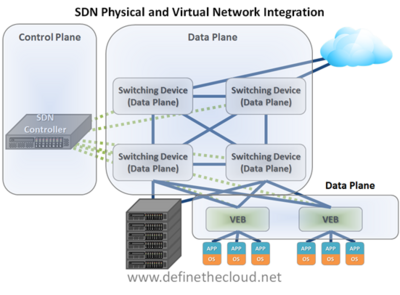As defined by Margaret Rouse, editorial director of WhatIs.com, software-defined networking (SDN) is “an approach to networking in which control is decoupled from hardware and given to a software application called a controller.” This term has gained significant traction among network engineers and administrators of late, but due to its immaturity and a small repository of proven success stories, there remains some confusion regarding its true benefits and purpose.

Software Defined Networking via Wikibon
We’ve put together a list of five software-defined networking myths we’ve seen making their rounds in the IT space, while offering some thoughts on each.
SDN is Just a Fad
.
- The SDN industry is about to take-off without looking back. According to a recent report (which classifies SDN technologies into four categories: SDN switching, SDN controllers, cloud provisioning and orchestration, and security and services), the global SDN market is expected to reach $3.52 billion by 2018. SDN is piggy-backing off the virtualization phenomenon that’s been moving across datacenters, shifting the focus from computing hardware to network infrastructure. Hardware and software virtualization have been around for quite some time, making networks the next likely target of “virtual” evolution.
SDN is Equal to Virtualization
.
- Network virtualization is just one application of the broader SDN meaning. SDN is described as a mechanism, while network virtualization is a solution. SDN can be applied to graphic engineering, security, policy or network virtualization while network virtualization itself, is a solution set customers use to change structure of their network. SDN can be paired with server virtualization, but is not a necessity. Simply implementing network functions in software is not SDN. Virtualization and SDN have their own identities and remain separate.
SDN Only Has Financial Impacts
.
- Industry professionals believe SDN may allow for commoditized networking equipment to be the way of the future, thus reducing costs. While reduced costs are at the top of most decision-makers’ lists, this isn’t the only driving force behind SDN. In an ideal world, SDN would drive down costs while offering IT professionals a mechanism that encompasses elasticity, flexibility, and interoperability.
SDN is a Hardware Killer
.
- As SDN has emerged, its moniker as a “hardware killer” has developed. The truth is, a successful SDN needs to be paired with high-performing hardware, network operating systems, and a general awareness of what’s happening with the controller and applications. Given this web dependency and SDN’s reliability on existing hardware, there is actually a substantial opportunity for hardware innovation to occur despite claims of looming doom.
SDN Presents Significant Security Liabilities
.
- Security concerns have always been a focal point (and challenge) for IT professionals. So, when new concepts emerge like SDN, security concerns are always quick to follow. Despite some potential risks, SDN will simplify extending network segments beyond the building perimeter, increasing the chances of data remaining secure. Vague boundaries make it difficult for IT professionals to determine where to install firewalls. SDN can allow internal and perimeter traffic to be routed through one central firewall.
As the SDN market continues to grow, its definition, capabilities, and effects on IT will all come into better focus. Like anything else, it will take time for it to become fully established, and until then, it will be a classic case of “wait and see.” However, we hope these myths and some of our input has helped clear some of the convoluted air surrounding the SDN space.
A message from John Furrier, co-founder of SiliconANGLE:
Support our open free content by sharing and engaging with our content and community.
Join theCUBE Alumni Trust Network
Where Technology Leaders Connect, Share Intelligence & Create Opportunities
11.4k+
CUBE Alumni Network
C-level and Technical
Domain Experts
Connect with 11,413+ industry leaders from our network of tech and business leaders forming a unique trusted network effect.
SiliconANGLE Media is a recognized leader in digital media innovation serving innovative audiences and brands, bringing together cutting-edge technology, influential content, strategic insights and real-time audience engagement. As the parent company of SiliconANGLE, theCUBE Network, theCUBE Research, CUBE365, theCUBE AI and theCUBE SuperStudios — such as those established in Silicon Valley and the New York Stock Exchange (NYSE) — SiliconANGLE Media operates at the intersection of media, technology, and AI. .
Founded by tech visionaries John Furrier and Dave Vellante, SiliconANGLE Media has built a powerful ecosystem of industry-leading digital media brands, with a reach of 15+ million elite tech professionals. The company’s new, proprietary theCUBE AI Video cloud is breaking ground in audience interaction, leveraging theCUBEai.com neural network to help technology companies make data-driven decisions and stay at the forefront of industry conversations.



